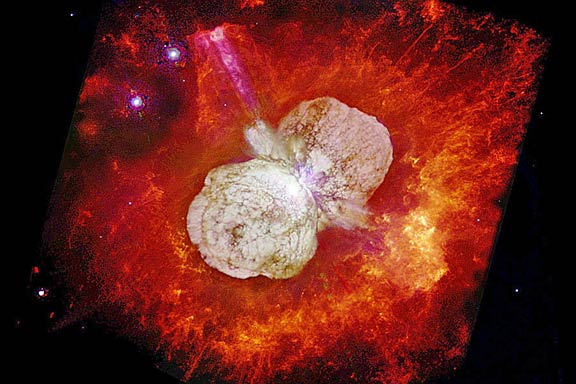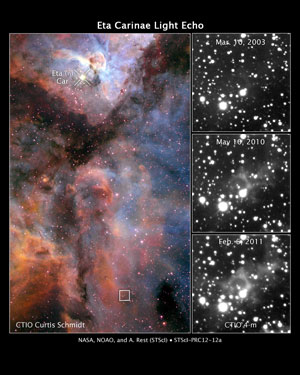Eta Carinae is one of our Milky Way
galaxy’s most massive, most luminous, and most bizarre stars. Well,
actually, it is a binary system of two very massive stars; one contains
over 100 times, and the other about 30 times, our Sun’s mass. These two
stars release 5 million times more light energy than our Sun, and
are one of the 20 most massive stars in our galaxy. Below is a
recent Hubble space telescope image of the environs of Eta Carinae. What
we see is a vast nebula, 20 times more massive than our Sun, spanning
about 3 trillion miles. All this is gas ejected by the massive star that
lies hidden within.

From 1837 to 1858, Eta Carinae exploded
spectacularly, peaking in 1843 to become the second brightest star in
our night sky after Sirius. (Sirius seemed brighter only because it is
about 900 times closer to Earth.) Unfortunately, this remarkable event
occurred before cameras and modern telescopes existed; we have only
notes taken by astronomers who used the much smaller telescopes of that
period.
If you happened to miss the action 170
years ago, don’t worry. We can now seeing cosmic reruns due to “light
echoes.” The image below illustrates how this is possible.

Eta Carinae exploded in about 5660 BC, at
a distance of 7500 light-years from Earth. Recall that one light-year
is the distance that light travels in one year. Hence, light from that
explosion took 7500 years to reach Earth, arriving 170 years ago. But
the light spread out in all directions. Some of that light hit a large
dust cloud and was reflected, and some of that reflected light headed
toward Earth. Astronomers call the reflected light a “light echo.” The
reflected light took a longer path to reach us, traveling first to the
dust cloud and then onward to Earth, It thus took more time to reach us
than did the direct light beam. In fact, the path of the reflected light
was 1000 trillion miles longer so it took an extra 170 years to get
here, arriving just recently.
The left side of the image below shows
the Carinae Nebula, with Eta Carinae near the top and the position of
the dust cloud in the boxed area below. On the right side are three
close-up pictures of the dust cloud taken on: March 10, 2003; May 10,
2010; and Feb. 6, 2011. The dust cloud images show progressive
brightening as the explosion intensified 7670 years ago. We are now
watching (for the second time) the explosion proceeding as if in real
time. In reality, what we see is delayed by the travel time of light
across vast cosmic distances. We are seeing the past unfolding in our
telescopes.

The Eta Carinae explosion was quite
unusual in that it extended over 20 years and was not a true supernova,
as one might expect from such a massive star. Indeed, the changes in
light intensity that astronomers now observe in the reflected light
match the light intensity changes recorded by astronomers who observed
the original blast 170 years ago. Based on that, we can expect more big
“burps”.
In the longer term, Eta Carinae is a
prime candidate to become a supernova or even a hypernova, explosions
that would make the 1840’s event look like a hiccup. That prior
explosion is just the rumbling of an unstable, immense star in the death
throes, preceding its final catastrophic explosion. Astronomers expect
that final explosion to occur anytime between next Tuesday and a million
years from now.
We haven’t had a good supernova in our
galaxy for 400 years. We are long over due, but it might be nicer if it
were a bit farther away. At 7500 light-years, life on Earth will
probably not be imperiled. The greatest danger at this distance would be
from a gamma ray burst, but these narrow beams of immense energy
typically shoot out along the star’s axis of rotation. Some astronomers
claim Eta Carinae’s axis is not pointed in our direction. Hopefully
they’re right.
Best Regards,
Robert
March 26, 2013
Note: Previous newsletters can be found on my website
|